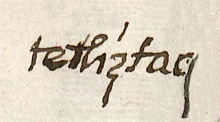Tetl Iztac (CmpRG)
This is a compound glyph for the landscape feature of known as Tetl Iztac (or Tetliztac), which we would translate into English as “white stone [hill/mountain].” It appears on the 1580 Relación Geográfica de Cempoala (Zempoala, Hidalgo). It consists of a tepetl) (hill, mountain) with what appears to be a white wash on its upper two thirds. This coloring represents the “white” (iztac) element in the hill’s name. The hill itself represents a stylistic variation on the standard Nahua depiction of such landscape features, perhaps revealing a certain amount of Spanish cultural influence. Because of the preponderance of white on its surface, the more common green shading is relegated to its base, which also has black-outlined pink stripes, curled at each end. Two spiky elements flank the hill’s summit, taking the place of the usual curling rocky tetl outcroppings that are often found at the top and/or on the slopes of a tepetl (see below). These stone crags (te-) could double as the start the word for tepetl. Whatever the case, the tepetl serves at least as a semantic indicator for a named place.
Robert Haskett
On the Cempoala map there is no church clearly associated with the landscape feature, a pairing that usually indicates an inhabited place. However, the white stone on the mountain landscape is surely what gives the neighboring altepetl (town, but called a "cabecera," head town in Spanish) of Tetliztacan its name. This latter community has its own Relación Geográfica that states this this place name “means hill of white stone, called that because of hills with white stone.” The implication is that the white stone peaks are nearby (folio 1 recto). In fact, the place glyph for this community is similar to the image found on the Cempoala map. On the Tetliztacan map there is a deliberate pairing of the hill with a church; they are connected by a red line (Relación de Tetlistaca, https://collections.lib.utexas.edu/catalog/utblac:d6867ccb-092b-47b1-87a...). Since there are a few exceptions to the hill-church pairing on the Cempoala map, it is just possible that its “Tetliztac” refers to both the landscape feature and the pueblo of Tetliztacan. There is a church in the vicinity on the map, which though it seems to be associated with a different place, could possibly be serving to indicate more than one community in what is a fairly crowded area of elements (see the historical contextualizing image). For more information about the Relación, see Mundy, Barbara E., “Mapping Babel: A Sixteenth-Century Indigenous Map from Mexico,” The Appendix, 1:4 (October 2013), Mundy (1996), and Ballesteros García (2005), 65-66.
Robert Haskett
tetliztaq
Tetl Iztac
Robert Haskett
1580
Robert Haskett
hills, mountains, cerros, white, blanco, rocks, stones, piedras, Tetliztac
tepe(tl), hill, mountain, https://nahuatl.wired-humanities.org/content/tepetl
te(tl), stone, rock, https://nahuatl.wired-humanities.org/content/tetl
iztac, white, something white, https://nahuatl.wired-humanities.org/content/iztac
cerro de piedra blanca
Robert Haskett
Relación de Cempoala - University of Texas Libraries Collections. 1580-11-01. https://collections.lib.utexas.edu/catalog/utblac:f87917e2-e3c9-4eb2-a83...
Materials that are in the public domain (such as most of the maps in the PCL Map Collection) are not copyrighted, and no permission is needed to copy them. You may download them and use them as you wish. The image appears here courtesy of the University of Texas Libraries, The University of Texas at Austin. If you do publish anything from this database, please cite the Visual Lexicon of Aztec Hieroglyphs.




